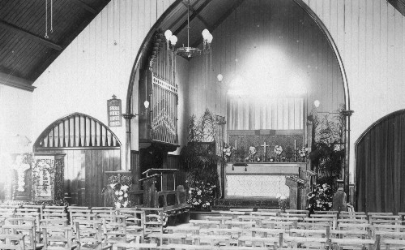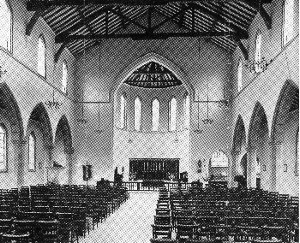St Matthew's History
Since 1880, a congregation have been worshipping here in the Anglo-Catholic tradition.
The following information is from "St Matthew's: the story of a Church", by the late Marjorie Cole.
Cottenham Park School
Long before the congregation of St Matthew’s had a church, people in the district were coming together to worship in the Anglo-Catholic tradition. Around 1880, Sunday services were held in a classroom of the original Cottenham Park School.
Avenue Road
Later, a small hall in Avenue Road was rented. At that time it stood in the midst of fields!
Durham Road
In 1895, a little iron church was erected at the corner of Durham Road and Richmond Road - now the site of a block of flats.
Corner Durham and Spencer Road
However, the iron church was soon too small for the expanding congregation. So a piece of land was bought at the corner of Durham Road and Spencer Road, the site of the present church. Ernest Shearman’s design for a Basilica type of church was chosen. The iron church building was then used as a hall, the home of such organisations as a flourishing youth club.
Building of the new church began in 1908. By 1909 the East end and one bay had been completed, enough for services to be held. The photograph below was taken around 1912. The remainder of the building was dedicated in 1927.
The postcard below, found in Marjorie Cole's collection of photographs, shows the Shearman church in about 1930.
The church actually had twin turrets, but from this camera position one turret is scarcely visible. The south east turret housed a bell which could be rung directly from the Lady Chapel. The Spencer Court flats were built around 1934, so the postcard pre-dates that year. At the time of the postcard, St Matthew's had a flagpole. There are no unsightly street signs or road markings.
A bomb hit the Spencer Road side of the building and a large part of the church was completely destroyed. The rest had to be pulled down because it was unsafe. The house at 53 Durham Road, built in 1922, survived.
At the Durham Road entrance stands the 1914-18 War Memorial. Frederick John Foster, reputedly the first Server ever to be appointed at St Matthew's, was among those honoured there. When the church hall was built, around 1937, the crucifix from the Memorial - which had survived the bombing - was transferred to the gable end of the new building, where it still hangs.
The ground on which the Shearman church would be built was consecrated in 1909. The first extension to be built - consisting of two bays - was dedicated in 1927. The time lapse is explained by the intervention of the First World War.
When the Shearman church came into use, the iron church in Durham Road was used as a church hall for meetings, youth groups etc. Around 1937/38 the site was sold off to finance the building of the new hall.
At the outbreak of war in 1939, blackout restrictions meant that all services had to be held in daylight hours. Midnight Mass was celebrated by the light of torches and one small lantern.
At 8.30pm on 29 June 1944 the church was totally destroyed by a flying bomb.
In spite of this, the people of St Matthew’s continued to worship together. The Priest-in-Charge of Christ Church offered hospitality, and for a time the two congregations worshipped in the same building at different times.
To maintain its identity, the St Matthew’s congregation once again sang Evensong in the bitterly cold Cottenham Park School. At the same time it was possible for some months to hold a daily Eucharist in the Sacristy of the bombed church - until the danger from falling masonry became too great.
In 1946 these temporary arrangements came to an end when a new priest arranged for St.Matthew's services to be held in an upper room at Raynes Park Methodist Church.
The next move was back to the repaired St Matthew’s Hall. This came to be known as "Little St Matthew’s", dedicated at the Patronal Festival in 1948.
In 1952, Sebastian Comper was asked to prepare plans for a new St.Matthew's. The foundation stone was laid in 1957.
Text from the newspaper clipping below: "Work on the new St.Matthew's Church is nearly finished. Soon it will be filled with worshippers who, for several years, have had to use the building on the left of the picture after the original church was bombed."
On 6 December 1958 the new church - in which we now worship - was dedicated.
The following two pictures show St Matthew's Church as it is today - the pictures were taken in 2001.
The two paintings below hang in the vestry.
Once again, thanks to the late Marjorie Cole who supplied most of the photographs and information (collated for her book 'St.Matthew's: the story of a Church').






























